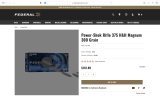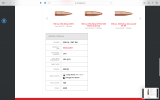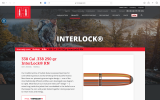Thank you so much for your recommendations, Rookhawk! I always feel better about my choices when running it by with somebody with experience. I am just curious, don't you like the 160 grain NP? Since you like the 156 grain Oryx, what about the 230 grain Oryx for larger....or maybe all plains game? Would you have taken something else if you were in my shoes, that I haven't listed?
@Capebuffalo I'm not an expert or a ballistician, I'm just a fellow traveller on the same journey you're on. I have my personal experiences, the anecdotes of people I trust, and the physics/properties of the bullets that I combine to render an opinion.
You asked why I don't like Nosler Partitions. I owned two cases of 7x57mm 175gr Nosler Partitions. Definitely, a big bullet for a safari 7mm. I used both cases for target shooting, preparation for hunting, and for several safaris and NA hunts. My experiences matched the lore and legend of the heavy-for-caliber Nosler Partitions EXACTLY. Both good and bad.
1.) Heavy for caliber bullets penetrate well and dump their energy with their "hang time" killing effect. This phenomenon was understood very well more than a century ago. It's why the 7x57 standard was 175-180gr, its why the 6.5x55 standard was 160gr. It's why the big bores do so darned well for all history launching >40 call bullets over 400gr at 2150fps. *Fact set 1*
2.) Nosler partitions frange. Weak, unbonded front ends splinter up when they hit weak bone, whereas the tail of the partition operates like a solid driving deep. There isn't an 80 year old elk hunter on the planet that doesn't have the stories of how good a Partition worked in a relatively weak caliber like a 7x57 or a .270. When they work as planned, they devastate. BUT, frangibility of a partition is not consistent. Every shot gets you a different result depending on how they hit a rib or shoulder. A lot of game hit squarely were unrecovered too. That's likely because the bullet franged, causing an inconsistent mushroom that deflected the front end particles into a non-lethal hit and the "solid" rear deflected into a non-lethal location. That's why I don't like NPs. Both of the anecdotes are true, and I don't like the randomization of expansion that makes it the bullet that has the most negative-positive arguments around a campfire. *Fact Set 2*
Oryx is a tougher bullet. A-Frame is the irrefutable king of heavy-for-caliber softs. The Barnes TTSX is the alternative, but you're trading heavy for calber lead for light-for-caliber copper. That means the A-frame is killing with ballistic trauma, the TTSX may be killing with "Roy Weatherby" "speed kills". (hydrostatic shock/sheer) Unless I need the flatter shooting of copper, I'd rather have the 22% greater mass by volume of lead. (A-Frame)
So if you had infinite resources and all known bullets available, for your 338 I'd absolutely tell you to use an A-Frame. For your 7x57 I'd recommend a big nasty bullet for closer work, 160-175gr. If you can't get a-frames, I'd go to the proven woodleigh weldcore SP since it was made for that caliber at that velocity.
Everything I say above is consistent with the reflections of Pondoro Taylor a 100 years ago. I'm not arguing his TCO math or his theories, I'm simply saying his reflections and anecdotes of what worked well are true, I just believe the causation of the success is more nuanced than he did.






